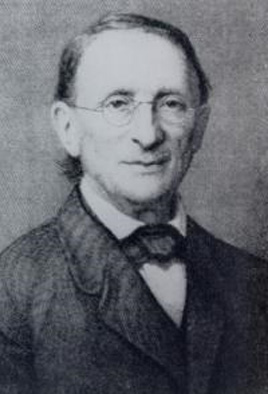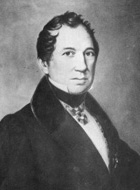Carl Ludwig
Carl Friedrich Wilhelm Ludwig ( born December 29, 1816 in Witzenhausen, Hesse-Cassel, † April 23, 1895 in Leipzig ) was a German physiologist.
Life and work
Carl Ludwig was the third son of Friedrich Ludwig (1781-1843) and Christiane Ludwig, nee Nagel ( † 1853). After the family moved to Hanau he attended from 1825, the country's High School, a humanistic gymnasium, and lay there in 1834 Matura examination.
Ludwig studied medicine in Marburg in 1834, from 1836 to 1838 in Erlangen and then to the surgeon school in Bamberg. In 1839 he was finally a doctorate in Marburg. Since 1835, he was a member of the country team Guestphalia and 1839 one of the founders of the Corps Hasso Nassovia whose honorary member in 1840.
In 1842 he completed his habilitation in Marburg with his work De viribus physicis secretionem of urine adjuvantibus ( "Contributions to the theory of the mechanism of secretion of urine "). With this work, he was averse to the then prevailing notion of a Vis vitalis and postulated that the urine primarily arises as a filtrate of the glomeruli of the driving force of blood pressure and its final composition get through resorption along the renal tubules. Remained unknown to him the active Sekretionsvorgänge that contribute to the formation of the Endharns.
1846 Ludwig was an associate professor of comparative anatomy at the Anatomical Institute in Marburg. From 1846 onwards Ludwig also worked on the development of the kymograph, an important gauge for investigations in the field of circulatory physiology and phonetics. So could from the curves that were recorded by measurements of the carotid and Pleuradrucks in dogs and horses, are shown among other things that systole and expiration increase the Karotisdruck, during diastole and inhalation lower it. In 1868, he developed the electricity meter to determine the average flow strength in larger arteries and veins and the second volume.
After professorships in Zurich and Vienna, he went in 1865 to the University of Leipzig, where he established the named after him today Physiological Institute, where he conducted research on topics such as blood pressure, diuresis and anesthesia. Some of his students were Otto Frank and Wilhelm Ellenberger.
In addition to his activities in physiology, he was also active in physical chemistry. He published in 1856 the first discovery of the thermal diffusion, the later named after him and Charles Soret ( 1854-1904 ) Ludwig- Soret effect.
Honors
In 1884, Carl Ludwig for his research, the Copley Medal. Five years later, in 1889, he became a Knight of the Order Pour le Mérite for Arts and Sciences and the following year a freeman of the city of Leipzig.
Since 1932, Carl -Ludwig- Medal of the German Society of Cardiology for many years of outstanding research in the field is the heart and circulatory awarded research. According to him, the Carl -Ludwig- Institute is named for Physiology, University of Leipzig.
Works
- Textbook of human physiology. C. F. Winter, Heidelberg, 1852 First volume. Physiology of the atoms of the physical states of the nerves and muscles. C. F.. Winter, Heidelberg 1852 ( digitized and full text archive in the German text, digitized )
- Second volume. Structure and decay of the juices and tissues. Animal heat. C. F.. Winter, Leipzig and Heidelberg, 1856 ( digitized and full text archive in the German text, digitized )


.jpg/220px-Carl_Ludwig_(physiologist).jpg)






